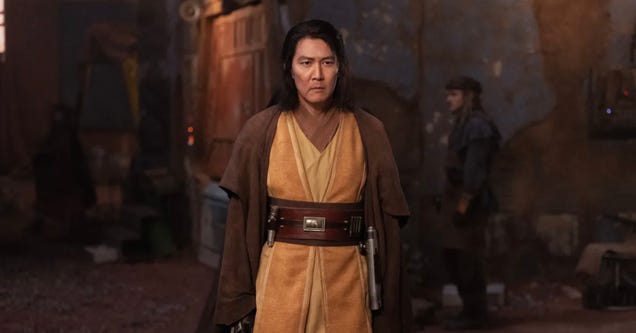Full disclosure: While I’m aware of The Acolyte’s interconnectivity to the Star Wars: High Republic comic books, I’ve only read a few issues and don’t follow the back and forth with the intensity of a “serious fan.” I’m watching the show on its own merits, and at least so far, am impressed by the strong storytelling. (Still, as I write this review weeks after the premiere, I am aware of the growing controversies around the show. No doubt I’ll get to them later, but for now, I’m reviewing the show effectively in a bubble—until it is impossible not to.)
Suggested Reading
Suggested Reading
Episode 2 (“Revenge/Justice”) draws us deeper into the mystery of why a young woman trained in the Force would embark on a surreptitious mission of gruesome vengeance against the (supposedly) honorable Jedi Knights. One puzzler, though, gets resolved as we finally see Mae, our Jedi-killer, sharing the screen with her twin sister Osha, the Jedi dropout turned space mechanic. (Both are played convincingly by Amandla Sternberg.)
Advertisement
Mae has now set her lethal gaze on Master Torbin (Dean-Charles Chapman), the veritable dean of Jedi mind tricks. When Mae finds him, he’s levitating in a deep meditative repose, shielded by an invisible force field generated by his aura. (You didn’t know inner peace was also a pretty effective security system, did you?) However impressive Mae’s fighting skills are, she’s got nothing on Torbin’s quantum level of zen. So she resorts to a more accessible Plan B—poison!—acquired from her fellow acolyte Qimir (Manny Jacinto). But how to get Torbin to drink it? Here, Mae deploys that other, all too familiar poison: guilt.
Advertisement

Advertisement
Guilt—messy and gnawing—casts a long shadow over this episode. Turns out the Jedi had something to do with the fire that destroyed Mae’s home, and Master Torbin wrestles with the weight of that. Herein lies the paradox of the Jedi, and why they remain such steadfastly intriguing figures in science fiction: their quasi-religious quest for transcendence requires overcoming destructive human instincts, like envy and a thirst for power. But tucked away behind those big feelings are the more discreet, but no less devastating sensitivities that plague humans, guilt chief among them. Humans do confounding things to assuage our guilt.
And it turns out Mae’s superpower isn’t her martial arts mastery, it’s her uncanny ability to exploit some of the faintest emotional vulnerabilities of her Jedi masters. She is a master manipulator.
Advertisement
We’ve seen these frailties from Jedi before: recall that Yoda was reluctant to allow Obi-Wan to train Anakin Skywalker in Attack of the Clones because both had attachment issues which clouded their judgment. And here, too, we see how a shared trauma can exert power even years later, influencing people to make questionable decisions. These layers are why The Acolyte feels so relevant and modern. Is it possible to ever truly put the past behind you?
Mae offers absolution to Master Torbin in exchange for consuming the deadly elixir. How could he possibly refuse? Such is the heavy burden of guilt, and credit to The Acolyte for giving us a new understanding of what it really means to rest in peace.
Advertisement
While it’s unclear if Mae’s offer of forgiveness was in earnest, Master Torbin’s death is, in fact, redemptive as it makes clear that Osha, who’s been in custody, has been framed by her twin. Not surprisingly, the Jedi use Osha to dupe her toxic mixologist Qimir, who lures Mae out of hiding. But the trap goes south, and after an edge-of-your-seat battle with Jedi Master Sol (Lee Jung-jae), Mae escapes.
There’s no overstating the choreographed wirework fighting in this scene. It is, in a word, entrancing, with echoes of The Matrix. I’m hoping it’s a glimpse of more to come. The Acolyte’s liberal use of wide shots and unusual angles is a subtle nod to perspective.
Advertisement
I’m thinking a lot about perspective as I rewatch the entire Skywalker saga with my 9-year-old son. It’s his first time, and there are few joys as pure as watching with a newbie. (An acolyte, as it were.) In some ways, The Acolyte proves deeply faithful to the foundations of Star Wars lore. The sets feel both other-worldly, yet familiar and steely; the costumes tailor-made for cosplay (part of my personal barometer of a franchise’s resonance). And the story so far sees flawed characters navigate a world where weakness has far-reaching implications.

